
| Go Articles
|
 |
|
| Setpiece Kos |
This series of articles has its origins in research carried out for a book on ko fights, in collaboration with Kim Seong-june 6 dan. While it remains highly desirable that a dan-level book on ko should be written, it is currently hard to see how to get such a work published.
Therefore I intend to create a series of web articles on a major theme to do with ko. I'll be assuming a working knowledge of ko: see references at the end for introductory web pages, books and articles.
The title is to be understood in various ways. Two of the easier aspects of ko to study are kos in the opening, and in the endgame.
Kos that arise in the early plays of a game are normally short, because of the absence of many adequate threats. That means that it is quite possible to read them to the end. There are even some standard sequences for ko threats against enclosures, such as this one:
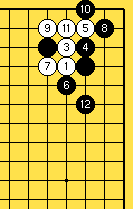
These can be learned by heart, if you want - they also prove useful in the case of ladder-breakers, a subject that is smaller than ko, but has some connections. As usual, though, it is possible to become a less perceptive player if you simply memorise sequences.
For example, if Black answers ko threats against the enclosure, we may get these positions:
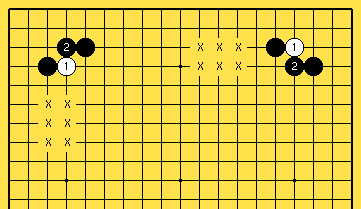
Which of these two is better for White will depend very much on possible plays on the 'x' points, or at least in those directions. The right-hand exchange will sometimes be better, though both exchanges are potential losses, illustrating the idea that ko threats are bad moves (plays you'd rather not make).
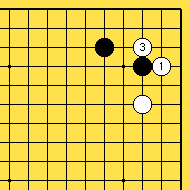
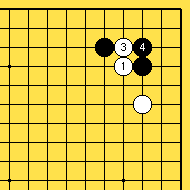
A second warning: in positions like this the pros usually play 1 (left) as a ko threat. The presence of the white stone in front of the enclosure completely changes the feeling. Now White will take the corner and Black has a weak group to defend on the top side.
In contrast, if White breaks through the enclosure with 1 and 3 (right), Black 4 makes it likely that Black will solve the problems here by living in the corner.
Therefore, while typically kos in the opening can be read by amateur players, the few ko threats that there are may require intelligent handling. This isn't such a good context for setpiece (joseki-like) thinking.
In contrast ko fights in the endgame are all about counting. One doesn't expect large groups to die in the endgame: that's what the middlegame is for. Therefore some trades should occur, in a kind of limited warfare. The theory of endgame kos is becoming reasonably well developed. The central idea of 'temperature' in positions is certainly useful, and later on in the series I'll show how to take account of its impact on the process of fighting kos.
By the way, it may seem logical to proceed in a treatment of ko directly from its definition as a rule either to discussion of the rules in general (ko-like phenomena), or to a description of algorithmic approaches to fighting kos based on the players' supplies of threats. This isn't what I'm going to do, and the reasons are similar to my decision to defer the temperature concept for a while. Putting it in a few words, the existing models of ko are still inadequate for discussion of middlegame kos.
So what I want to do is to apply 'setpiece' ideas to middlegame kos, by referring directly to material from real games. Of course one can find literally thousands of high-level examples of ko fights in pro games. There are several aspects here, that go beyond the obvious need to read and count before taking decisions:
This series of articles is intended to discuss these points 1, 2 and 3 quite thoroughly, with about eight parts given to each (to appear over the next year).
Further, behind these quite important ideas (for ambitious amateur dan players) there are some basic points about the nature of the game as ko affects it:
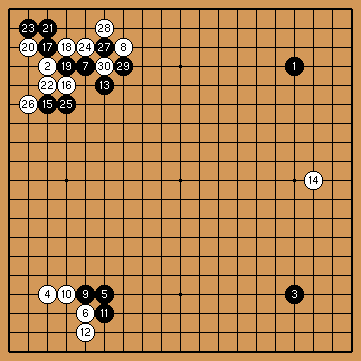
(1-30)
White tries a rather unusual plan with 2 and 4
against Black's nirensei. In order to break out of a
one-sided position White plays 14 on the right, but then
White needs a way of handling the upper left corner.
Black sets up a ko with 27 and 29, a powerful shape
combination.
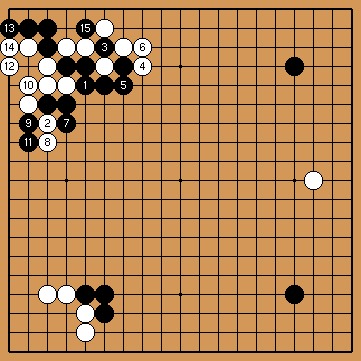
(1-15)
Firstly Black protects his own shape - Black 5 is
typical good shape around a ko, where playing one point
to the right would mean that White's capture in the ko
becomes atari. After 15 the ko looks serious - where are
White's threats? But Black has to find the first threat.
There is one, below 12, but playing it would give White
a second eye.
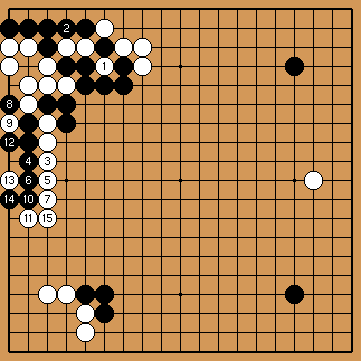
(1-15)
White's intention is something different. Up to
15 makes seki on the left edge.
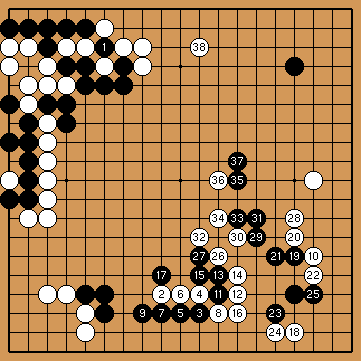
(1-38)
The influence White built on the left side is put
to use in a whole-board strategy. Up to 38 White has
probably levelled the game on the board, so leads by
komi (4.5). White won by 5.5.
This isn't an example that has much to do with ko technique, though the way Black set up the ko is a standard pattern. But it is a very good illustration of a game that becomes unbalanced early on, because of a ko. Hashimoto was noted for brilliant play, and this is a beautiful, flexible game from him.
There are now many web pages dealing with ko fights and ko rules. The following are introductory: A B C D E
These are a little more advanced: F G
There are useful discussions on the Sensei site: H I J K L M
Rob van Zeijst has written about ko in his Yomiuiri series, for example: N O P
Books in English: there is just one devoted to ko, Fighting Ko by Jin Jiang (Yutopian). There are useful chapters in Proverbs (Yutopian) and Attack and Defense by Ishida and Davies (Kiseido). Books on life-and-death contain many thousands of problems showing how ko fights may arise affecting the status of stones, but usually say nothing about what happens after that. Kos are also important as part of endgame tesuji technique.
In Japanese there are a few major references on ko. The Ko Dictionary by Murashima was published in 1973, and contains 350 pages of useful technical material. A Nihon Ki-in book The Ko Addict by Rin Kaiho has recently been reissued under a different title. A less well-known book Ko Investigation by Segoe from 1976 is the best I have seen, or the closest to my point of view anyway.
There were some useful magazine articles on ko in Go Review many years ago, in particular by Fujisawa Hideyuki. The model of ko I shall develop later is that given in 'Analyzing Ko Struggles Theoretically' by Karel Tavernier, published in issue 110 (Spring 1998) of the British Go Journal.
| Posted 25 May 2002. Copyright © 2002 Charles Matthews | ||
| Index | Next edition |